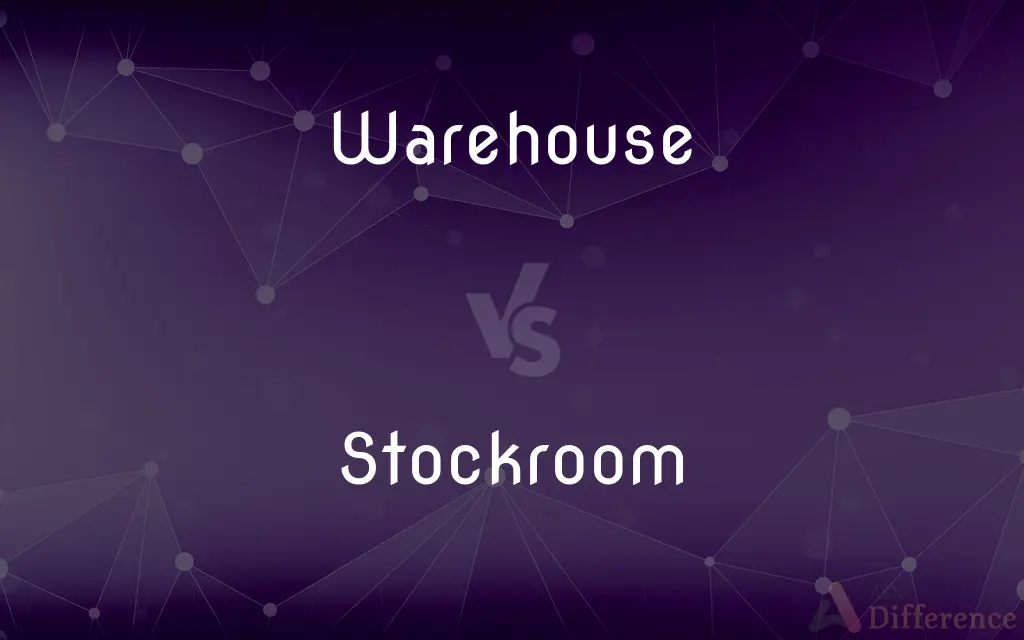Warehouse vs. Stockroom — What's the Difference?
By Maham Liaqat & Urooj Arif — Updated on March 10, 2024
A warehouse is a large industrial space for storing goods in bulk before distribution, while a stockroom is a smaller area, often within a retail or office setting, for holding inventory for immediate use or sale.

Difference Between Warehouse and Stockroom
Table of Contents
ADVERTISEMENT
Key Differences
Warehouses are typically expansive facilities located strategically to facilitate logistics and distribution, often featuring loading docks, cranes, and forklifts for handling large quantities of goods. Stockrooms, in contrast, are more modest in size and are usually situated within or adjacent to retail stores, offices, or restaurants, serving as storage for items that will soon be used or sold directly to consumers.
The primary function of a warehouse is to store products and goods on a large scale, serving as a hub in the supply chain where items are received from manufacturers and then shipped to retailers or directly to consumers. Stockrooms, however, mainly serve to keep a back-up inventory that replenishes retail shelves or supplies an office or facility with necessary items, ensuring smooth daily operations.
Warehouses often utilize sophisticated inventory management systems to track goods, manage stock levels, and optimize logistics operations, given the vast amount of products they handle. Stockrooms, while they may also use inventory systems, tend to have simpler setups due to the smaller scale and less complex requirements of inventory tracking and management.
The operation of a warehouse typically involves specialized staff and equipment for tasks like inventory management, packing, shipping, and receiving, reflecting the industrial scale of its operations. Stockroom operations, on the other hand, are generally managed by retail or office staff and require minimal specialized equipment, focusing more on immediate accessibility and convenience.
Comparison Chart
Size
Large, industrial-sized facilities.
Smaller, often within retail or office settings.
ADVERTISEMENT
Location
Strategically located for logistics, often outside city centers.
Located within or adjacent to the place of use or sale.
Function
Bulk storage for distribution in the supply chain.
Holding inventory for immediate use or retail sale.
Inventory Management
Advanced systems for tracking and logistics.
Simpler systems, focused on accessibility and replenishment.
Operations
Requires specialized staff and equipment.
Managed by retail or office staff with minimal specialized equipment.
Compare with Definitions
Warehouse
Designed for large-scale storage and distribution.
The warehouse stored goods from various manufacturers for regional distribution.
Stockroom
Serves as back-up storage for retail spaces.
The stockroom held extra inventory to replenish the shop floor.
Warehouse
Equipped with loading docks for trucks and freight.
The warehouse's loading docks were busy with incoming shipments.
Stockroom
Accessible for quick retrieval of items.
Staff frequently accessed the stockroom to keep shelves fully stocked.
Warehouse
Often part of a complex logistical operation.
The logistics company optimized its warehouse operations to improve delivery times.
Stockroom
Sometimes doubles as a space for preparing items for sale.
Price tagging and inventory checks were done in the back stockroom.
Warehouse
Utilizes pallet racks and bulk storage systems.
High-stacked pallet racks maximized the warehouse's storage capacity.
Stockroom
May organize items by immediate need or popularity.
Bestselling items were kept at the front of the stockroom for easy access.
Warehouse
Can be specialized for different types of goods.
The temperature-controlled warehouse was perfect for storing perishable items.
Stockroom
Essential for managing day-to-day operations.
The restaurant's stockroom was organized daily to ensure smooth service.
Warehouse
A warehouse is a building for storing goods. Warehouses are used by manufacturers, importers, exporters, wholesalers, transport businesses, customs, etc.
Stockroom
A room in which a store of goods or materials is kept.
Warehouse
A large building where raw materials or manufactured goods may be stored prior to their distribution for sale.
Stockroom
A room where a store keeps its stock of merchandise.
Warehouse
Store (goods) in a warehouse
The pallets were warehoused the following day
Stockroom
Storeroom for storing goods and supplies used in a business
Warehouse
Place (a prisoner or a psychiatric patient) in a large, impersonal institution in which their problems are not satisfactorily addressed
Our objective is not to warehouse prisoners but to help inmates build new lives
Warehouse
A place in which goods or merchandise are stored; a storehouse.
Warehouse
A large, usually wholesale shop.
Warehouse
To place or store in a warehouse, especially in a bonded or government warehouse.
Warehouse
To institutionalize (a person) in usually deficient housing and in conditions in which medical, educational, psychiatric, and social services are below par or absent
"has felt forced to warehouse hundreds of children in temporary shelters" (Justine Wise Polier).
Warehouse
A place for storing large amounts of products. In logistics, a place where products go to from the manufacturer before going to the retailer.
Warehouse
(transitive) To store in a warehouse or similar.
Warehouse
(transitive) To confine (a person) to an institution for a long period.
Warehouse
To acquire and then shelve, simply to prevent competitors from acquiring it.
The warehousing of syndicated TV shows
Warehouse
A storehouse for wares, or goods.
Warehouse
To deposit or secure in a warehouse.
Warehouse
To place in the warehouse of the government or customhouse stores, to be kept until duties are paid.
Warehouse
A storehouse for goods and merchandise
Warehouse
Store in a warehouse
Common Curiosities
Can a warehouse serve as a fulfillment center?
Yes, many warehouses also function as fulfillment centers, where goods are received, processed, and shipped to customers.
Can stockrooms be used for online order fulfillment?
Yes, particularly in retail settings, stockrooms can serve as fulfillment centers for online orders, though this is more common in smaller operations.
What is the primary function of a warehouse?
The primary function of a warehouse is to store large quantities of goods, typically for wholesale or distribution purposes.
Are there any specific regulations governing warehouse operations?
Yes, warehouses must comply with various regulations regarding safety, building codes, and sometimes specialized storage requirements for certain goods.
How do businesses decide between using a warehouse or a stockroom?
This decision is based on the scale of the business, the volume of goods handled, and the logistical needs of storing and distributing their products.
Are warehouses always separate from retail spaces?
Typically, yes, due to their industrial size and logistical functions, but some large retail operations may have attached warehouse space.
How does technology impact warehouse and stockroom management?
Technology, especially inventory management systems, optimizes operations, improves accuracy, and can significantly reduce manual labor in both settings.
What types of items are typically stored in a stockroom?
Stockrooms commonly hold a limited supply of products intended for immediate sale or use within the business, such as retail goods or office supplies.
Can a business operate without a warehouse?
Yes, particularly small businesses or service-oriented businesses may not require warehouse space and can operate with just a stockroom or direct shipments.
How do businesses decide between using a warehouse and a stockroom?
The decision depends on the business's size, the volume of goods, storage needs, and whether they require direct access to products for immediate sale.
How does a stockroom differ from a warehouse in terms of size?
A stockroom is generally much smaller than a warehouse and is usually located within or adjacent to a retail store or business premises.
What security measures are common in warehouses?
Warehouses often have security measures like surveillance cameras, security personnel, and access control systems to protect the stored goods.
Are warehouses equipped with special facilities for handling goods?
Yes, warehouses are often equipped with facilities like loading docks, forklifts, and sometimes climate-controlled areas for specific types of goods.
Do warehouses play a role in inventory management?
Yes, effective warehouse management is crucial for inventory control, ensuring that goods are properly stored, accounted for, and accessible when needed.
How do environmental conditions affect warehouse and stockroom storage?
Certain goods may require controlled environments, such as refrigeration or humidity control, which must be considered in both warehouse and stockroom settings.
What is the role of a stockroom manager?
A stockroom manager oversees the organization, stocking, and retrieval of goods in the stockroom, ensuring that items are readily available when needed.
How does the location of a warehouse affect its efficiency?
The location can significantly impact efficiency, especially in terms of logistics and transportation costs, with ideally situated warehouses reducing transit times and expenses.
Share Your Discovery

Previous Comparison
UPS vs. USPS
Next Comparison
Manifest vs. LatentAuthor Spotlight
Written by
Maham LiaqatCo-written by
Urooj ArifUrooj is a skilled content writer at Ask Difference, known for her exceptional ability to simplify complex topics into engaging and informative content. With a passion for research and a flair for clear, concise writing, she consistently delivers articles that resonate with our diverse audience.














































